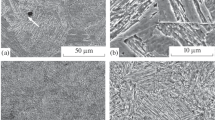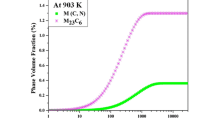Conclusions
-
1.
Shatter cracks are nucleated and grow after a certain incubation period, the length of which becomes shorter with an increase in the hydrogen content of the sample, the residual stresses, the carbon content, and the grain size.
-
2.
The assumption [1–3] that shatter cracks are formed instantaneously in the transformation of retained austenite into martensite due to “thermal explosion” resulting from the heat liberated in the formation of molecules from atomic hydrogen precipitated from the solution at a rate matching the formation rate of martensite needles is in error.
-
3.
Shatter cracks can be prevented by a combination of cooling conditions and final heat treatment (normalization, improvement) ensuring refining of the microstructure and substructure and the maximum values of the static and dynamic toughness at a given strength.
Similar content being viewed by others
Literature cited
E. S. Tovpenets and G. P. Vypov, Fiz. Metal. Metalloved.,11, No. 1 (1961).
E. S. Tovpenets, Heat Treatment of Rolled and Forged Sections [in Russian], Gostekhizdat UkrSSR, Kiev (1962).
E. S. Tovpenets, in: Technology and Organization of Production [in Russian], No. 5, Kiev (1968).
E. S. Tovpenets and G. P. Vypov, Fiz. Metal. Metalloved.,23, No. 4 (1967).
V. S. Mes'kin, Stal', No. 8 (1956).
S. S. Shteinberg Shatter Cracks in Steel [in Russian], Metallurgizdat, Sverdlovsk (1939).
I. N. Golikov et al., Stal', No. 12 (1953).
A. A. Rastorguev and D. A. Litvinenko, Reports of the Scientific and Technical Society of Ferrous Metallurgy [in Russian], Vol. 15, Metallurgizdat, Moscow (1959).
A. A. Rastorguev and D. A. Litvinenko, in: Collection of Reports of the Central Scientific-Research Institute of Ferrous Metallurgy, Special Steels and Alloys [in Russian], No. 17, Metallurgizdat, Moscow (1960).
Kh. Forverk, Chernye Metally, No. 9 (1963).
I. E. Brainin, Fiz. Metal. Metalloved.,12, No. 3 (1961).
E. Houdremont and H. Korschan, Stahl und Eisen,55, No. 11 (1935).
V. Ya. Dubovoi, Shatter Cracks in Steel [in Russian], Metallurgizdat, Moscow (1950).
I. D. Pichakhchi, Metallurg, No. 9 (1939).
Yu. V. Grdina and L. B. Krepysheva, Izv. Vuzov. Chernaya Metallurgiya, No. 6 (1964).
P. T. Besedin, in: Metal Science and Heat Treatment [in Russian], Metallurgizdat, Moscow (1958).
P. T. Besedin et al., Stal', No. 10 (1960).
S. Z. Bokshtein et al., Metal. i Term. Obrabotka Metal., No. 5 (1969).
M. Hill and E. Johnson, Trans. Met. Soc. AIME,221, No. 6 (1961).
Additional information
Donets Polytechnical Institute. Translated from Metallovedenie i Termicheskaya Obrabotka Metallov, No. 1, pp. 44–47, January, 1971.
Rights and permissions
About this article
Cite this article
Brainin, I.E. Shatter cracks and the effect of heat treatment conditions on the elimination of hydrogen from steel. Met Sci Heat Treat 13, 46–48 (1971). https://doi.org/10.1007/BF00663778
Issue Date:
DOI: https://doi.org/10.1007/BF00663778




